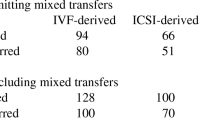Abstract
Purpose: To examine the effect of intracytoplasmic sperminjection (ICSI) on embryo fragmentation and implantationrates in those embryos chosen for transfer compared toconventional in vitro fertilization (IVF).
Methods: We compared 253 infertility patients (71 ICSI and182 IVF) with respect to age, semen analysis, number ofembryos transferred, embryo fragmentation, implantationrate, and pregnancy rate. Embryo fragmentation wasdetermined by one observer at the same laboratory over the entirestudy period.
Results: A statistically significant difference was observedin mean embryo grade between IVF (2.2 ± 0.84) and ICSI(2.5 ± 0.77), P = 0.01. Additionally, the IVF patients hadsignificantly more nonfragmented (grade I) embryoscompared to the ICSI group, P < 0.01.
Conclusions: These data suggest that ICSI, irrespective ofsemen parameters, may increase embryo fragmentation andproduce fewer nonfragmented grade I embryos while maintaining implantation and pregnancy rates similar toconventional IVF.
Similar content being viewed by others
REFERENCES
Van Steirteghem AC, Nagy Z, Joris H, Liu J, Staessen C, Smitz J, Wisanto A, Devroey P: High fertilization and implantation rates after intracytoplasmic sperm injection [see comments]. Hum Reprod 1993;8:1061–1066
Palermo G, Joris H, Devroey P, Van Steirteghem AC: Pregnancies after intracytoplasmic injection of single spermatozoon into an oocyte. Lancet 1992;340:17–18
Sherins RJ, Thorsell LP, Dorfmann A, Dennison-Lagos L, Calvo LP, Krysa L, Coulam CB, Schulman JD: Intracytoplasmic sperm injection facilitates fertilization even in the most severe forms of male infertility: Pregnancy outcome correlates with maternal age and number of eggs available. Fertil Steril 1995;64:369–375
Serhal PF, Ranieri DM, Kinis A, Marchant S, Davies M, Khadum IM: Oocyte morphology predicts outcome of intracytoplasmic sperm injection. Hum Reprod 1997;12:1267–1270
Cohen J, Alikani M, Malter HE, Adler A, Talansky BE, Rosenwaks Z: Partial zona dissection or subzonal sperm insertion: Microsurgical fertilization alternatives based on evaluation of sperm and embryo morphology. Fertil Steril 1991;56:696–706
Cohen J, Talansky BE, Malter H, Alikani M, Adler A, Reing A, Berkeley A, Graf M, Davis O, Liu H, et al.: Microsurgical fertilization and teratozoospermia. Hum Reprod 1991;6:118–123
Grow DR, Oehninger S, Seltman HJ, Toner JP, Swanson RJ, Kruger TF, Muasher SJ: Sperm morphology as diagnosed by strict criteria: Probing the impact of teratozoospermia on fertilization rate and pregnancy outcome in a large in vitro fertilization population [see comments]. Fertil Steril 1994;62:559–567
Nagy ZP, Verheyen G, Liu J, Joris H, Janssenswillen C, Wisanto A, Devroey P, Van Steirteghem AC: Results of 55 intracytoplasmic sperm injection cycles in the treatment of male-immunological infertility. Hum Reprod 1995;10:1775–1780
Nijs M, Vanderzwalmen P, Vandamme B, Segal-Bertin G, Lejeune B, Segal L, van Roosendaal E, Schoysman R: Fertilizing ability of immotile spermatozoa after intracytoplasmic sperm injection. Hum Reprod 1996;11:2180–2185
Parinaud J, Mieusset R, Vieitez G, Labal B, Richoilley G: Influence of sperm parameters on embryo quality. Fertil Steril 1993;60:888–892
Yang D, Shahata MA, al-Bader M, al-Natsha SD, al-Flamerzia M, al-Shawaf T: Intracytoplasmic sperm injection improving embryo quality: Comparison of the sibling oocytes of non-male-factor couples. J Assist Reprod Genet 1996;13:351–355
Oehninger S, Kruger TF, Simon T, Jones D, Mayer J, Lanzendorf S, Toner JP, Muasher SJ: A comparative analysis of embryo implantation potential in patients with severe teratozoospermia undergoing in-vitro fertilization with a high insemination concentration or intracytoplasmic sperm injection. Hum Reprod 1996;11:1086–1089
Bar-Hava I, Ashkenazi J, Shelef M, Schwartz A, Brengauz M, Feldberg D, Orvieto R, Ben-Rafael Z: Morphology and clinical outcomes of embryos after in vitro fertilization are superior to those after intracytoplasmic sperm injection. Fertil Steril 1997;68:653–657
Leondires MP, Escalpes M, Segars JH, Scott RTJ, Miller BT: Microdose midfollicular phase GnRH-a compared to luteal phase GnRH-a for ovarian stimulation at IVF. Fertil Steril 1999; press.
World Health Organization: WHO laboratory manual for examination of human semen and sperm-cervical mucus interaction. Cambridge, England, Cambridge University Press, 1992
Veeck LL: Atlas of human oocyte and early conceptus, Vol. 2. Baltimore, Williams & Wilkins, 1991
Ron-el R, Nachum H, Herman A, Golan A, Caspi E, Soffer Y: Delayed fertilization and poor embryonic development associated with impaired semen quality. Fertil Steril 1991;55:338–344
Bourne H, Richings N, Harari O, Watkins W, Speirs AL, Johnston WI, Baker HW: The use of intracytoplasmic sperm injection for the treatment of severe and extreme male infertility. Reprod Fertil Dev 1995;7:237–245
Mansour RT, Aboulghar MA, Serour GI, Amin YM, Ramzi AM: The effect of sperm parameters on the outcome of intracytoplasmic sperm injection. Fertil Steril 1995;64:982–986
Clarke GN, Bourne H, Baker HW: Intracytoplasmic sperm injection for treating infertility associated with sperm autoimmunity. Fertil Steril 1997;68:112–117
Lundin K, Soderlund B, Hamberger L: The relationship between sperm morphology and rates of fertilization, pregnancy and spontaneous abortion in an in-vitro fertilization/intracytoplasmic sperm injection programme. Hum Reprod 1997;12:2676–2681
Moilanen JM, Tulppala M, Reima I, Hovatta O: Fertilization, embryo quality, and cryosurvival in in vitro fertilization and intracytoplasmic sperm injection cycles. J Assist Reprod Genet 1999;16:17–23
Coulam CB, Opsahl MS, Sherins RJ, Thorsell LP, Dorfmann A, Krysa L, Fugger E, Schulman JD: Comparisons of pregnancy loss patterns after intracytoplasmic sperm injection and other assisted reproductive technologies. Fertil Steril 1996;65:1157–1162
Tournaye H, Liu J, Nagy Z, Joris H, Wisanto A, Bonduelle M, Van der Elst J, Staessen C, Smitz J, Silber S, et al.: Intracytoplasmic sperm injection (ICSI): The Brussels experience. Reprod Fertil Dev 1995;7:269–278; discussion 278–279
Author information
Authors and Affiliations
Rights and permissions
About this article
Cite this article
Frattarelli, J.L., Leondires, M.P., Miller, B.T. et al. Intracytoplasmic Sperm Injection Increases Embryo Fragmentation Without Affecting Clinical Outcome. J Assist Reprod Genet 17, 207–212 (2000). https://doi.org/10.1023/A:1009439800398
Issue Date:
DOI: https://doi.org/10.1023/A:1009439800398




